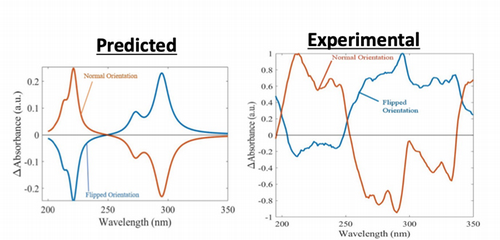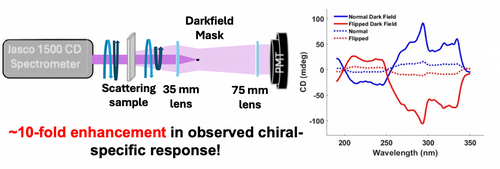Chiral Microspectroscopy
Chirality plays a fundamental role in molecular and supramolecular interactions, particularly in biological systems, and is typically studied using chiroptical spectroscopies. However, chiral-specific signals in isotropic media are often orders of magnitude weaker than achiral ones, limiting their analytical utility. In ordered assemblies, symmetry reduction enables new electric-dipole allowed mechanisms for chiral-specific spectroscopy, offering significantly enhanced sensitivity.
Our work has leveraged these principles in nonlinear optics to enabble selective detection of homochiral crystals using second harmonic generation (SHG) microscopy, aiding in protein and small-molecule crystal analysis. However, chiral imaging in anistropic materials presents challenges, as birefringence can interfere with isolating isotropic circular dichroism (CD) signals. Rather than treating these effects as artifacts, we explore how the heightened chiral sensitivity in CD and ORD (optical rotary dispersion) measurements in ordered assemblies can be harnessed for new instrumentation, provided predictive models connect molecular chirality to optical responses.
Expanding this electric-dipole framework, we have demonstrated chiral-specific and interface-specific effects in coherent four-wave mixing (4WM) spectroscopy. More recently, we estended this approach to fluorescence, interpreting absorption and emission as two-wave mixing processes within the same theoretical framework as 4WM.

To test these predictions, we studied thin films of drop-coated naproxen microcrystals (seen in Figure 1) in the UV-Vis spectral range. The orientation-dependent chiral response confirmed our theoretical model, with CD measurements showin sign inversion upon flipping the sample by 180 degrees, depicted in Figure 2.

More recently, we modified a CD spectrometer for low-angle scattering detection (seen in Figure 3) to enable the isolation of incoherent contributions to nonreciprocal CD achieving 5-to-10- fold enhancements in CD dissymmetry parameters.

Current research aims to experimentally assess these frameworks as extensions to hyper-Rayleigh scattering (HRS) and fluorescence-ORD through instrumentation and method development.
See our most recent publications below:
- Murati, K.; Higgins, A.J.; Clisham, C.M.; Litts, A.W.; Wilson, M.R.; Hwang, Y.; Polichetti, P.; Dunlap C.E.; Ku, T.; Simpson, G.J. Theoretical Foundation for Interface-Specific Hyper-Rayleigh Scattering in Uniaxial Chiral Assemblies. The Journal of Physical Chemistry B 2025 129 (19), 4651-4669. DOI: 10.1021/acs.jpcb.4c08140
- Turner, G.A.; Dunlap, C.E.; Higgins, A.J.; Simpson, G.J. Dark-Field Absorbance Circular Dichroism of Oriented Chiral Thin Films. The Journal of Physical Chemistry Letters 2025 16 (5), 1403-1408 DOI: 10.1021/acs.jpclett.4c02984
- Konstantinovsky SantiagoTremblaySimpsonHammes-SchifferYan E.C.Y. Theoretical basis for interpreting heterodyne chirality-selective sum frequency generation spectra of water. J. Chem. Phys. 7 February 2024; 160 (5): 055102. DOI: 10.1063/5.0181718
- Turner, G.A.; Hwang, Y.; Rong, J.; Strachan, C.; Simpson, G.J. Incoherent Nonreciprocal Absorbance Circular Dichroism of Uniaxial Assemblies. The Journal of Physical Chemistry B 2023 127 (38), 8216-8225 DOI: 10.1021/acs.jpcb.3c03104
- Sherman, A.M.; Takanti, N.; Rong, J.; Simpson, G.J. Nonlinear optical characterization of pharmaceutical formulations. TrAC Trends in Analytical Chemistry 2021; 140: 116241. DOI: 10.1016/j.trac.2021.116241.